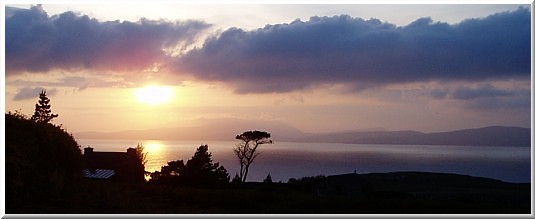We've lived here since May 2004; until the sixties it belonged to a local
family, whose relatives still live nearby.
Several farmers remember herding cattle and cutting hay from the drier meadows
here in their younger days. It was bought in the sixties by an American.
At this time a car, or even a tractor, on the peninsula was a rare sight;
the route to Ballyroon Mountain was unsuitable for motor vehicles, most farms
were self-sufficient for their simple needs.
In Kilcrohane the Co-op and an enterprising parish priest helped to build
up a flourishing butter collective, early daffodils and new potatoes were
sent by train from Bantry to Cork and Dublin.
Many sons and daughters left for work in USA and UK, leaving their parents
or a sibling to keep the farm going.
The American family stayed here until the 70's, after which a German family
used it as a holiday home for the next twenty-five years.
___________________
Going back further is a matter of conjecture, but here are some things we have
found so far:
- in Neolithic times the climate here was similar to the South of France
- there are some large stones lying around the farm, they have definitely
been moved, but who knows why, when and how
- in the Bronze Age SW Ireland was extremely important, it provided copper
ore for bronze-making, the ore was exported by sea to Western Europe
- the population of this part of Ireland in the Bronze Age was higher than
ever since
- Bronze Age mixed farming was very productive
- Bronze Age small stone-walled fields are now buried under layers of peat,
laid down as the climate became colder and wetter
- the most likely use of this land after the Bronze Age was for free-range
cattle-herding a la Wild West
- mediaeval times saw numerous feuds between local warlords
- in C15 and C16, many Spanish ships would have been seen from here, both
pirate and armada ships
- in 1601 the Spaniards took Dunboy Castle, opposite here
- in 1649 Cromwell's savage reign as General for Ireland began
- mass was forbidden, all livestock was destroyed, and the population of
Ireland decreased by a third (it had been nearly 1.5m)
- wolf packs in Munster increased, especially in isolated areas such as
this
- French fleet in Bantry Bay, 1689; landed French Irish & Scottish militia
- C17th and C18th: prohibition of export of Irish goods except by the English
resulted in a peasant economy based on the potato in this area; the general
standard of living was very low, but this wonder crop resulted in a rapid
population increase, the landscape was rapidly developed leading to a high
population density
- this included a system of boreens, parts still exist here, they are narrow
stone-walled tracks walls linking different levels and neighbours to one
another
- land-drains were dug, lined and covered with flat stones
- as were the numerous stone wall field boundaries, these took a great deal
of manpower and skill to build
- mass was held secretly outside, using a 'mass-rock' as an altar
- in 1796 the inhabitants of Ballyroon Mountain would have had a grandstand
view of the French Armada's unsuccessful invasion organised by Wolf Tone
- each family kept a few animals, usually a house-cow or goat, a pig or
two, and hens
- they grew cabbages and kale, leeks, onions and potatoes
- although the small creeks below us seem unlikely locations to launch
a boat, they were used to fish in suitable weather
- The Great Famine of 1845-7 did not spare Ballyroon Mountain, before it
there were at least seven extended families living in this valley
- the main part of the farmhouse is pre-famine, and of a typical pattern
for the area
- then it was most likely single-storey, with another door in the wall
opposite the front door, the house was used for both family and milk-cow,
which came in through one door and out the other
- the cooking was done in the large fireplace in a large iron pot (a bastible)
hanging over a turf fire
- like many similar farmhouses, this one was probably developed to two-storey
with grant-aid in the early 20th century
- until land reform in Ireland, farm families were short-term tenants and
had to pay annual rents, often in kind
- because of its remoteness and poor land, this end of the peninsula wasn't
a great source of wealth
- in C19th and C20th, copper mining and pilchard fishing were developed
on Sheep's Head, neither were viable long term
- in C20th, the land was divided and freehold title to the various lots
was allocated to the various families who lived in the valley
- electricity was connected here in the seventies, the deep well was bored
in the 1990's, and the access road from the top was greatly improved in
2005
Amanda Clarke's website www.sheepsheadplaces.net is a grand resource for the area. The history of Sheep's Head Peninsula is documented in the "A Guide
To The Sheep's Head Way" walk guidebook. There are other books on Bantry
Bay and South West Cork, and local museum collections in Bantry and Bantry
House. The Famine Heritage Centre in Skibereen documents the suffering of
this tragedy, West Cork was one of the worst affected parts of Ireland.

